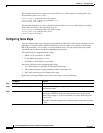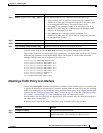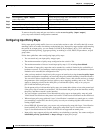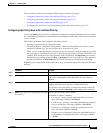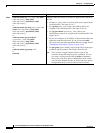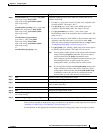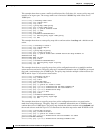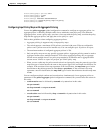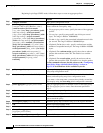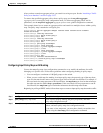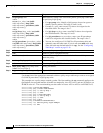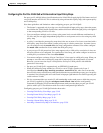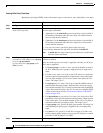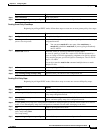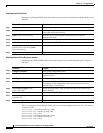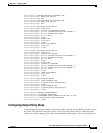
33-44
Cisco ME 3400 Ethernet Access Switch Software Configuration Guide
OL-9639-06
Chapter 33 Configuring QoS
Configuring QoS
Beginning in privileged EXEC mode, follow these steps to create an aggregate policer:
Command Purpose
Step 1
configure terminal Enter global configuration mode.
Step 2
policer aggregate aggregate-policer-name
{rate-bps | cir cir-bps} [bc burst- value]
[conform-action [set-cos-transmit
{cos_value | [cos | dscp | precedence] [table
table-map name]} | set-dscp-transmit
{dscp_value | [cos | dscp | precedence] [table
table-map name]} | set-prec-transmit
{precedence_value | [cos | dscp | precedence]
[table table-map name]} | set-qos-transmit
qos-group_value | transmit] [exceed action
[drop | set-cos-transmit {cos_value | [cos |
dscp | precedence] [table table-map name]} |
set-dscp-transmit {dscp_value | [cos | dscp |
precedence] [table table-map name]} |
set-prec-transmit {precedence_value | [cos |
dscp | precedence] [table table-map name]} |
set-qos-transmit qos-group_value |
transmit]]
Define the policer parameters that can be applied to multiple traffic
classes within the same policy map.
• For aggregate-policer-name, specify the name of the aggregate
policer.
• For rate-bps, specify average traffic rate in bits per second
(bps). The range is 8000 to 1000000000.
• For cir cir-bps, specify the committed information rate in bits
per second. The range is 8000 to 1000000000 bps.
• (Optional) For bc burst-value, specify conform burst and the
number of acceptable burst bytes. The range is 8000 to 1000000
bytes.
• (Optional) For conform-action, specify the action to take on
packets that conform to the CIR. The default is to send the
packet.
• (Optional) For exceed-action, specify the action to take on
packets that exceed the CIR. The default is to drop the packet.
See the command reference for this release or the “Configuring
Input Policy Maps with Individual Policing” section on
page 33-39 for definitions of the available keywords.
Step 3
policy-map policy-map-name Create a policy map by entering the policy map name, and enter
policy-map configuration mode.
Step 4
class {class-map-name | class-default} Enter a class-map name or class-default to match all unclassified
packets, and enter policy-map class configuration mode.
If you enter a class-map name, you must have already created the
class map by using the class-map global configuration command.
Step 5
police aggregate aggregate-policer-name Apply an aggregate policer to multiple classes in the same policy
map. For aggregate-policer-name, enter the name specified in
Step
2.
Step 6
exit Return to policy-map configuration mode.
Step 7
exit Return to global configuration mode.
Step 8
interface interface-id Enter interface configuration mode for the interface to which you
want to attach the policy.
Step 9
service-policy input policy-map-name Attach the policy map (created in Step 3) to the ingress interface.
Step 10
end Return to privileged EXEC mode.
Step 11
end Return to privileged EXEC mode.
Step 12
show policer aggregate
[aggregate-policer-name]
Verify your entries.
Step 13
copy running-config startup-config (Optional) Save your entries in the configuration file.



